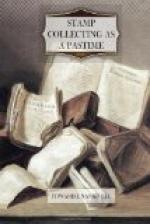Mr. W. Hughes Hughes, B.L., started his collection in 1859, and kept a strict account of all his expenditure on his hobby, and in 1896 he sold to our publishers for close on L3,000 what had cost him only L69.
In 1870 a stamp dealer in London, as a novelty and an advertisement, papered his shop windows, walls, and ceiling with unused Ionian Islands stamps, which were then a drug in the market. The same stamps would now readily sell at 10s. per set of three; in other words, the materials of that wall-paper would now be worth at least L5,000.
The late Mr. Pauwels, of Torquay, made a collection which cost him L360 up to 1871, when it was put on one side and left untouched until 1898. It was then purchased by our publishers for the sum of L4,000, and yielded them a very fair return on their investment.
In the International Philatelic Exhibition, held in the Galleries of the Royal Institute of Painters in Water Colours in Piccadilly, London, in 1897, one collector marked over each stamp of his exhibit the price which he had paid for it, and the market price of the day. The collection had been got together during the previous fifteen years, and had cost its owner L25 2s., while by the then latest catalogue value it totalled up to L368 1s. 3d.
Shrewd business men are those who frequently invest large sums in stamps. The amounts spent annually by some wealthy collectors range from L1,000 to L10,000. One well-known Parisian collector, whose life has been largely devoted to his philatelic treasures, and who employs two secretaries to look after his collection, has, it is estimated, spent at least L200,000 on his stamps since 1870.
If investment were the Alpha and Omega of stamp collecting, every collector of standing would bemoan lost opportunities. Many a great rarity of to-day could have been had for a few shillings a few years ago. The Cape errors were sold by Stanley Gibbons at 2s. 6d. each. The “Transvral” error was sold by the same generous firm at 4s., and others in similar proportion in the day of opportunity.
To-day it is the fashion to look back with regret on those lost opportunities, and to nurse the belief that such opportunities are never likely to return. But experience shows that in every decade of stamp collecting the common stamp of to-day may be the rarity of to-morrow. In many a series of stamps some one of the lot from some cause or another gets scarce, and the price appreciates from year to year till the original price paid for the stamp in pence is represented by pounds.
[Illustration]
XIV.
What to Collect and How to Collect.
The questions, “What to collect?” and “How to collect?” are much more easily asked than answered. Each individual will differ in taste, in inclination, in method, in time at his disposal, and last, but not least, in the depth of his pocket. The most that can be done is to outline a general plan, founded upon general experience.




